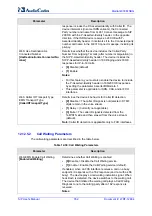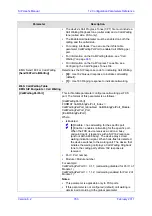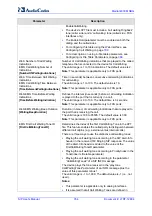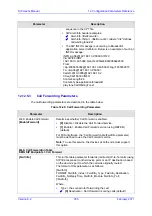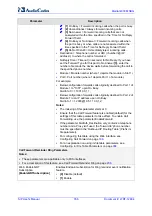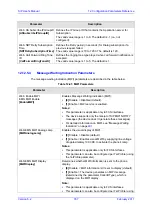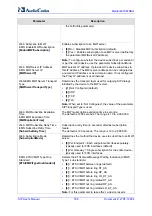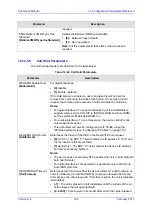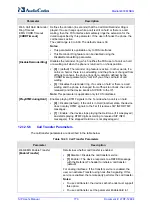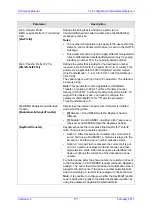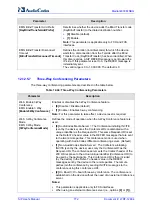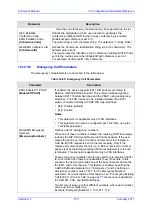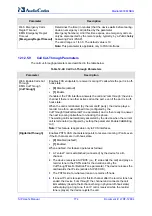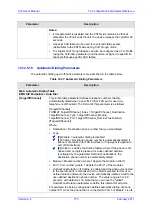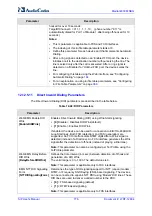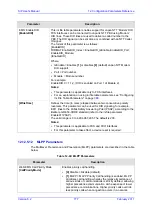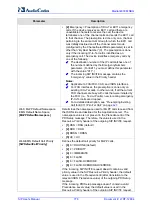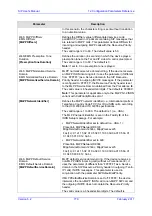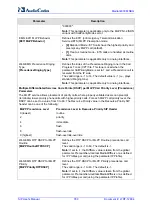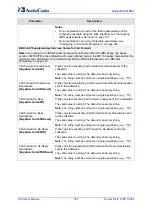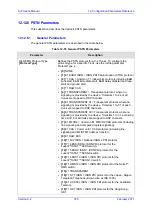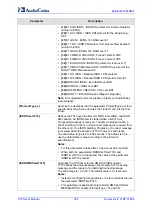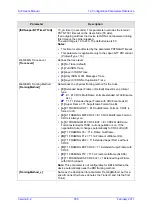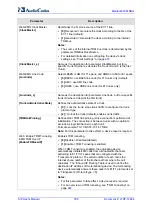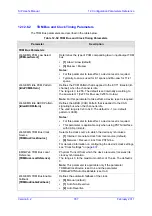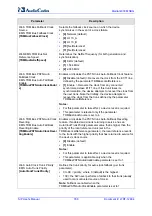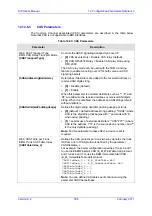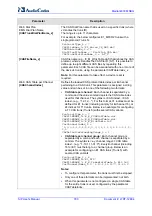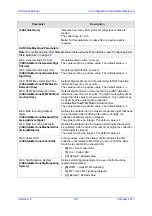
SIP User's Manual
776
Document #: LTRT-12804
Mediant 800 MSBG
Parameter
Description
hooked for over 10 seconds:
TargetOfChannel 0 = 911, 1, 1, 1 ,10; (phone number "911" is
automatically dialed for Port 1 of Module 1 after being off-hooked for 10
seconds)
Notes:
This is parameter is applicable to FXS and FXO interfaces.
The indexing of this
ini
file table parameter starts at 0.
Define this parameter for each device port that implements Automatic
Dialing.
After a ring signal is detected on an 'Enabled' FXO port, the device
initiates a call to the destination number without seizing the line. The
line is seized only after the call is answered. After a ring signal is
detected on a 'Disabled' or 'Hotline' FXO port, the device seizes the
line.
For configuring this table using the Web interface, see ''Configuring
Automatic Dialing'' on page
.
For an explanation on using
ini
file table parameters, see ''Configuring
ini File Table Parameters'' on page
.
12.12.5.11 Direct Inward Dialing Parameters
The Direct Inward Dialing (DID) parameters are described in the table below.
Table
12-48: DID Parameters
Parameter
Description
Web/EMS: Enable DID
Wink
[EnableDIDWink]
Enables Direct Inward Dialing (DID) using Wink-Start signaling.
[0]
Disable = Disables DID Wink(default).
[1]
Enable = Enables DID Wink.
If enabled, the device can be used for connection to EIA/TIA-464B DID
Loop Start lines. Both FXO (detection) and FXS (generation) are
supported. An FXO interface dials DTMF digits after a Wink signal is
detected (instead of a Dial tone). An FXS interface generates the Wink
signal after the detection of off-hook (instead of playing a Dial tone).
Note:
This parameter can also be configured per Tel Profile, using the
TelProfile parameter.
Web/EMS: Delay Before
DID Wink
[DelayBeforeDIDWink]
Defines the time interval (in msec) between detection of off-hook and
generation of a DID Wink.
The valid range is 0 to 1,000. The default value is 0.
Note:
This parameter is applicable only to FXS interfaces.
EMS: NTT DID Signalling
Form
[NTTDIDSignallingForm]
Determines the type of DID signaling support for NTT (Japan) modem:
DTMF- or Frequency Shift Keying (FSK)-based signaling. The devices
can be connected to Japan's NTT PBX using 'Modem' DID lines. These
DID lines are used to deliver a called number to the PBX.
[0]
= FSK-based signaling (default)
[1]
= DTMF-based signaling
Note:
This parameter is applicable only to FXS interfaces.
Summary of Contents for Mediant 800 MSBG
Page 2: ......
Page 366: ...SIP User s Manual 366 Document LTRT 12804 Mediant 800 MSBG Reader s Notes ...
Page 372: ...SIP User s Manual 372 Document LTRT 12804 Mediant 800 MSBG Reader s Notes ...
Page 390: ...SIP User s Manual 390 Document LTRT 12804 Mediant 800 MSBG Reader s Notes ...
Page 404: ...SIP User s Manual 404 Document LTRT 12804 Mediant 800 MSBG Reader s Notes ...
Page 616: ...SIP User s Manual 616 Document LTRT 12804 Mediant 800 MSBG Reader s Notes ...
Page 636: ...SIP User s Manual 636 Document LTRT 12804 Mediant 800 MSBG Reader s Notes ...
Page 652: ...SIP User s Manual 652 Document LTRT 12804 Mediant 800 MSBG Reader s Notes ...
Page 886: ...SIP User s Manual 886 Document LTRT 12804 Mediant 800 MSBG Reader s Notes ...

